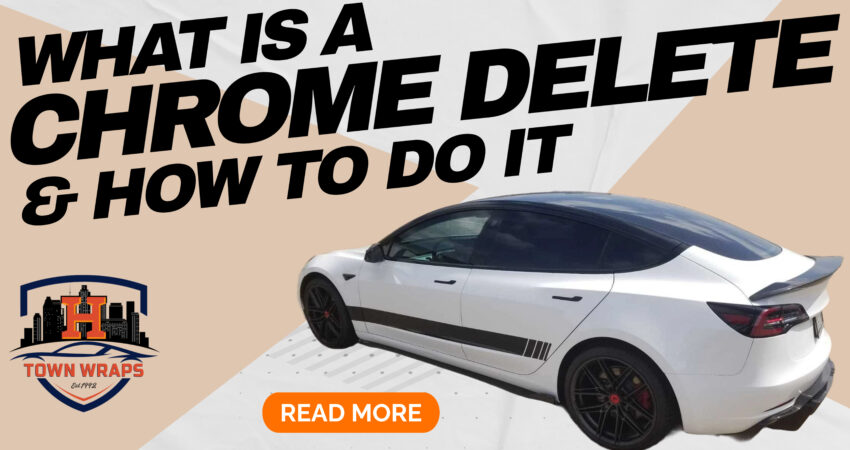Chrome delete is a car customization trend that involves modifying or concealing the chrome trim on a vehicle to give it a more contemporary and streamlined appearance. Chrome trim, which can be found on various parts of a car like window surrounds, door handles, grilles, and badges, has historically been associated with luxury and classic design. However, many car owners and enthusiasts now prefer a more understated and modern look, making chrome delete a popular choice. We’ll review what chrome delete is and explore the methods, tools, step-by-step guidelines, and considerations associated with this vehicle modification.

Methods for Chrome Delete
There are various approaches to achieve a chrome delete, each with its own set of advantages and disadvantages:
Vinyl Wrapping: One of the most widespread methods is using vinyl wrap to cover the chrome trim. Vinyl wrap is a versatile adhesive material that comes in different colors and finishes, offering an array of customization options without permanently altering the vehicle’s body. It is a reversible and cost-effective choice.
Plasti Dip: Plasti Dip is a temporary rubber coating that can be sprayed onto chrome accents. While not as durable as vinyl wrap, it provides a budget-friendly way to experiment with the chrome delete appearance. If you’re dissatisfied, you can peel it off.
Paint: Some car owners opt to paint the chrome trim to match the vehicle’s body color. This method necessitates meticulous preparation, including sanding, priming, and applying multiple coats of paint. It’s a permanent solution that can deliver a seamless, factory-like finish if executed correctly.
Aftermarket Replacements: Another option is to replace the chrome trim with aftermarket parts in a different finish, such as black or color-matched components. This method ensures a seamless appearance but can be more costly than the previous alternatives.
Tools and Materials Needed
The tools and materials required depend on the chosen method, but here is a general list:
- Vinyl wrap or Plasti Dip for wrapping or coating the chrome trim.
- A squeegee to eliminate air bubbles and ensure proper adhesion.
- A heat gun or hair dryer to shape and conform the wrap to the trim’s contours.
- Sandpaper and primer (for painting) to prepare the surface for paint adhesion.
- Masking tape and plastic sheeting to protect surrounding areas during painting or wrapping.
- Screwdrivers and trim removal tools for disassembling and reassembling the trim pieces.
- Cleaning supplies, including isopropyl alcohol, microfiber cloths, and adhesive remover to clean and prep the surface.
Step-by-Step Guide
For those considering a chrome delete using vinyl wrap, here is a general step-by-step guide:
- Prepare the vehicle: Thoroughly clean the chrome trim with isopropyl alcohol to remove dirt, grime, and any wax or polish residue.
- Measure and cut the vinyl wrap: Measure the length of the trim, adding a few inches for overlap. Cut the vinyl wrap to the appropriate size.
- Apply the wrap: Peel the backing of the vinyl wrap and carefully align it with the trim. Start from one end and use a squeegee to smooth out the wrap, removing any air bubbles. Utilize a heat gun to help the wrap conform to the trim’s curves and edges.
- Trim excess wrap: Use a utility knife to trim away the excess wrap, following the trim’s contours.
- Finish and inspect: Reassemble any removed parts and check for any imperfections or areas that may need rework.
- Clean and maintain: Regularly clean the wrapped trim with a mild soap and water solution to maintain its appearance and longevity.
Chrome Delete Considerations
Before embarking on a chrome delete project, it’s essential to take into account various factors:
- Reversibility: Decide whether you want a reversible modification or are comfortable with a more permanent change.
- Skill level: Different methods require varying levels of skill and experience. For example, painting the trim may require more expertise than using vinyl wrap.
- Cost: Each method has a different cost associated with it, so consider your budget.
- Durability: The longevity of the modification varies based on the method and materials used. Vinyl wrap may need periodic maintenance, while paint is more durable.
- Legal regulations: Be aware of local laws and regulations regarding car modifications, as excessive tinting or covering of certain vehicle components may be prohibited.
Chrome delete is a popular way to transform the appearance of a vehicle, providing it with a modern and personalized look. Whether you choose vinyl wrap, Plasti Dip, paint, or aftermarket replacements, careful planning and execution are essential to achieving the desired results. Consider your personal preferences, budget, and skill level, and always follow best practices for a successful chrome delete project that enhances your car’s aesthetics.
